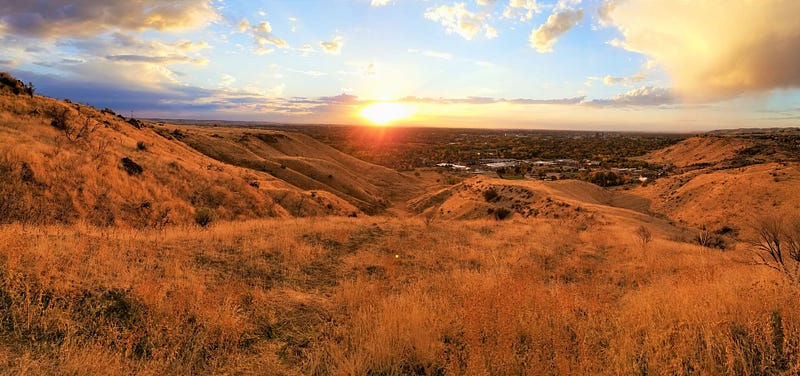We fled the California fires, and here we are

Photo by Ben Hoskyn on Unsplash
Living in Napa Valley was a dream come true, at first
In 2014 when we moved to the lovely little Wine Country town of St. Helena, we kept pinching ourselves. Here we were, going about our daily lives in the midst of a destination that people travel the world to visit. It was like the south of France, but with better coffee and nicer public restrooms. Year-round, morning and evening, we walked our dog along a levee trail that ran behind our neighborhood and led us through storied vineyards. One of the local bocce teams was sponsored by Francis Ford Coppola, who lives within the town boundaries, and he was a regular at the league tournaments. There were more wineries than we could possibly visit in our seven years there, although we did our best.
We’re native-born Californians who have lived through wildfire seasons in SoCal when the valleys were shrouded in smoke, the nighttime sky glowed at the edges from the lines of fire on the ridges, and ash dusted cars and floated on swimming pools. But we both spent our childhoods 400 miles north in the Bay Area, back when rain puddles still iced over on winter mornings and wildfires simply were not a thing. Moving to Napa County felt like coming home.
On a demonically windy night in October of 2017, our third year in Napa Valley, the Tubbs Fire erupted. That was the firestorm that spread through nearby Calistoga, south toward Napa, over the mountains to Santa Rosa and Sonoma, and became the deadliest wildfire in California history. The closest flames came within a mile and a half of us, but we emerged unscathed. Our cousins in Glen Ellen and several friends in Santa Rosa were not so lucky. They lost everything but their lives and pets.
That was sobering. After the Tubbs Fire, at the school where I worked kids became fretful when it was windy and hot, and even more so on days when the local winegrowers were allowed to burn the piles of pruned vines from the previous year. “Missus Flynn, I smell smoke,” they would tell me, wide-eyed, their adolescent bravura crumbling under collective PTSD. I would reassure them, feeling semi-honest.
Every year following, fire season got longer. And worse
In 2018 the Mendocino Complex Fire burned nearly 460,000 acres, setting another California record. The same autumn, the ironically named Camp Fire destroyed the entire town of Paradise. We weren’t in the direct path of either, but we huddled under a toxic pall of smoke for weeks, oppressed by a blend of dread and sadness. The next year, the Kincade Fire ate up over 77,000 acres in lovely Sonoma County, extending so far toward the ocean that previously immune coastal havens like Bodega Bay were evacuated.
And then came last year, the infamous 2020. The August Complex Fire in the Coastal Range burned through six counties and became the first “gigafire.” Other lightning complex fires devastated swaths of the East Bay and, further south, the Santa Cruz mountains.
In the last days of September, eight months into pandemic lockdown, a fire started on Glass Mountain, right up the road from us. For the next 23 days, the Glass Fire roared through Napa and Sonoma Counties. The sky turned a ghastly shade, casting the whole Bay Area into a day-long twilight of an apocalyptic burnt-orange hue. The air quality index was in the high 600s.
We packed ourselves, our dog, and our most valuable and portable possessions into our car and fled north overnight to our family in Idaho. There we sheltered, masked and socially distant from our generous loved ones, anxiously following the news and wondering if we would have a house to return to.
Five days later we drove the 600 miles back home. The superhuman efforts of Cal Fire and our first responders had kept our neighborhood and our sweet small town intact. But cinders and blackened leaves littered our street, and we were aghast to see that the fire had come to within a football field’s distance of us.
That put us over the edge
We had other reasons for returning to the home we’d kept and had rented out in Boise — family and finances among them — but the Glass Fire, which had burned up so much of our surrounding hills and our favorite hiking trails, cinched it. We were getting out. Idaho, we knew, is hardly immune, but its colder winters bring a definite and blessed end to fire season.
This spring we put our St. Helena house on the market. In June I said goodby to my coworkers, finished packing, and on June 26 we were on the road again, back to our bucolic Boise ‘hood.
And straight into the dome of hellacious heat that has locked down over the Pacific Northwest and spread into British Columbia. We haven’t experienced the ungodly temperatures of poor Portland, Oregon, which averaged an unheard-of 112 degrees over at least five days. But it has been in the triple digits here since we arrived a week ago, and there is no letup in sight.
Southern Idaho does get hot in the summertime. But not this hot, for this long, until now. And it cools off nicely at night. Until now. The lows have only gotten down to about 73 degrees, for maybe an hour around 6:00 AM. It makes me wonder if indeed winter is coming. That’s new. That’s weird.
That’s climate change. And it turns out you can’t outrun it.
Comments